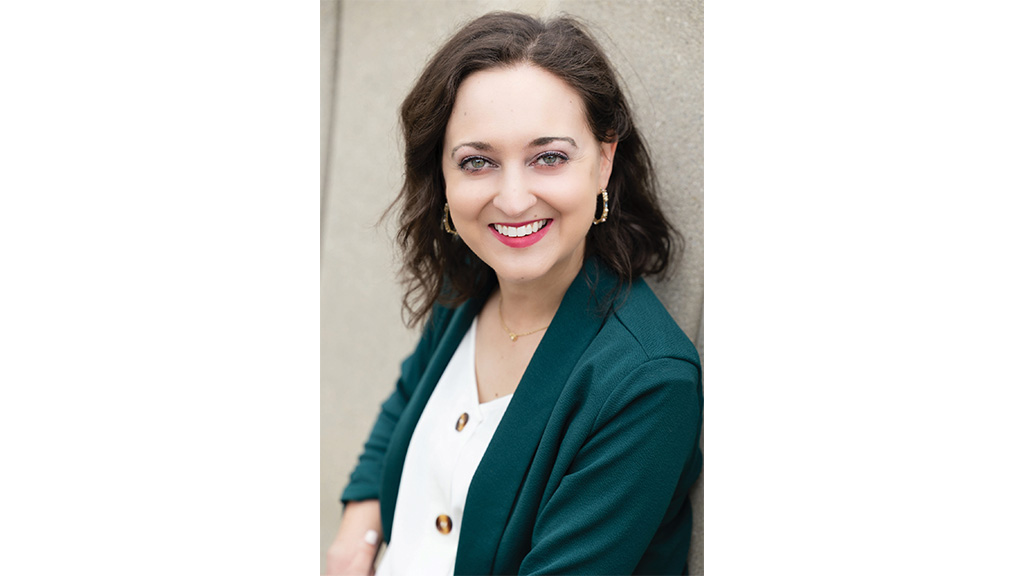
PHOTO CREDIT: LILY CHRIS PHOTOGRAPHY
Rebecka Peterson, the 2023 National Teacher of the Year, sounds a bit nostalgic as she discusses the opening of the new school year. Instead of welcoming students to her Tulsa classroom and beginning her 12th year as a secondary math teacher in Oklahoma’s Union Public Schools, Peterson has been on the road, meeting with teachers, education leaders, and other audiences across the country, shining a spotlight on the joys of teaching and the “good and important work of educators.”
She says she will miss the energy and optimism of the back-to-school season, but that sadness is a reminder that “[w]hat I had in room 2704 of Union High School was very, very real, and that the joy and the attention that we put into getting our spaces ready for learning and for growth is the opportunity of a lifetime. I’m very grateful for that.”
Peterson spoke with ASBJ Associate Editor Michelle Healy about the challenges facing teachers today, how intentionally focusing on the positive things happening in her classroom saved her career, and how her immigrant experience helps her connect with students.
After earning degrees in mathematics, with an emphasis in advanced calculus, you planned to pursue a career as a college math professor. Why the shift to secondary education?
My husband and I had been trucking along pretty hard, completing our master’s programs, when we decided to take a little break. I took a job at Tulsa Community College, and part of my assignment was teaching concurrent classes at Union High School. (Students earn college credit while also satisfying high school graduation requirements.) Part of my day was at the high school, and part was at one of the community college campuses. I developed a great relationship with the team at Union, particularly the principal at the time, Lisa Witcher. After a year teaching in both settings, she said, “I’d rather you be teaching 140 of my students than just 40.” I got alternatively certified, and she hired me. The rest is history.
At Union High School, you’ve taught everything from intermediate algebra to Advanced Placement Calculus. What’s kept you in the classroom?
The students. They give me so much hope for the future. And I love who I am when I’m in the classroom. My students inspire me to bring my most creative, authentic, true, and innovative self. Ask somebody to name an influential person in their childhood, and almost everybody names either a family member or a teacher. I can’t think of another profession where people are thought of like this or held in others’ hearts for years and years. What a beautiful way to spend your days.
The teaching profession is undergoing significant challenges related to pay, staffing, burnout, and other issues. Still, you encourage your students to consider teaching careers?
I don’t dismiss the very valid concerns that teachers are raising. I don’t dismiss them at all. The more I think about it, the more committed I am to helping us reframe the profession because if we’re not excited about our work, why would anyone consider going into it? If we don’t have people going into this field, who’s going to be teaching our kids and our grandkids? Who’s going to be our colleagues? I urge future teachers to work to be the teacher that they needed as a student.
Like many first-year teachers, you weren’t sure you would survive year one. What changed?
I stumbled upon the community blog “One Good Thing,” where teachers write about the good things happening in their classrooms. I thought, “What do I have to lose?” I started writing and really saw a shift in my mindset, a shift in how I was approaching my work. My brain started seeing more and more good things. I became the author of my own story.
And you now incorporate that same journaling concept into your math classes?
Every Friday, my students get out their math journals and flip to the very last page. They take two minutes to be quiet, rest their minds, and reflect on something good. It can be a word, a phrase, a sentence, a whole page, whatever they want. I tell them, if it wasn’t a good week, I’m sorry. I’ve been there. I know those weeks. But I also know that it is our duty as human beings to write our own stories. So right now, let’s take two minutes and write something good.
You’ve described yourself as being culturally ambiguous as a child, the result of being an immigrant of Swedish-Iranian descent who lived in various countries as your parents worked as medical missionaries. Did that experience impact you as a teacher?
We lived in Tajikistan in Central Asia my freshman year of high school. At the time, 80% of the population lived below the poverty line. It’s practically desert. It was a completely different culture and very untethering. To swing back to Oklahoma for my last three years of high school was maybe even more untethering. I remember walking into a Walmart and having this visceral reaction to just how much stuff was within one building and thinking this was more than an entire country might see in its lifetime. What is so beautiful to me now is that the district I landed in, Union, is one of the most diverse districts in the state. We have 62 languages represented here. A lot of my students are also immigrants or first-generation Americans. They know what it’s like to have one foot on the inside and one foot on the outside. So, it has come full circle for me because that which used to untether me now tethers me to my students.
(The National Teacher of the Year program is sponsored by the Council of Chief State School Officers. This interview was edited for length and clarity.)

Share this content